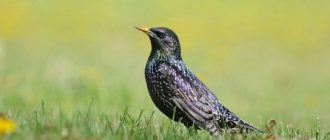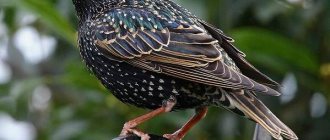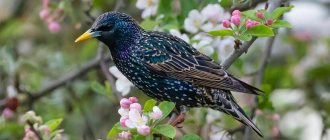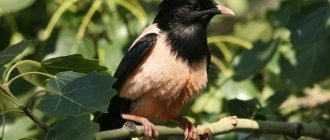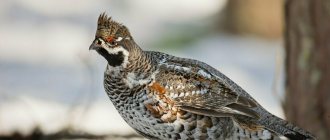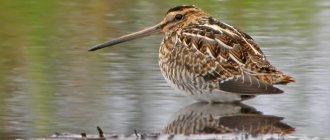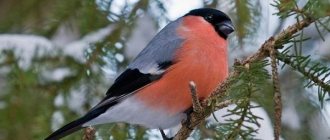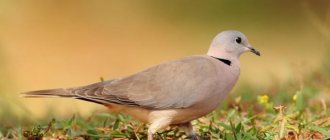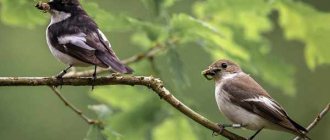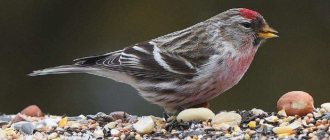Good afternoon friends, each of us undoubtedly perks up with the arrival of an unusually beautiful spring, the time of year when starlings arrive.
It is not for nothing that these first migratory birds, arriving to us from the warm south, are called the harbingers of spring.
Spring itself is a wonderful beginning of life, and the first sign of its approach is not the arrival of fat black rooks and nimble, swift swallows, but the final arrival of song starlings.
The gentle warmth of the first days of March drives these birds to their native lands, so the swift-winged birds are in a hurry to return home.
Their cheerful and joyful voices are heard throughout the vast land, notifying everything around with a loud call - the starlings have arrived, the starlings have arrived, they have brought spring on their wings.
Description and features of the starling
When the starling bird , many people remember their childhood and teenage years, how they made houses for birds, which were called birdhouses.
Pictured is an amethyst starling
Although many did not think about this in childhood, many still have such associations. Unfortunately, not many people have information about the life of this amazing bird; some even have difficulty imagining exactly what starlings look like, but this can be corrected by looking at photos of starlings and reading a few notes about the life of these birds.
First of all, I would like to note that the starling belongs to the starling family and is part of the passerine order. Starlings are medium-sized birds. The body length is about 20 centimeters, the wings reach 13 centimeters in length, and the tail length reaches 6 centimeters.
When flying, the wingspan sometimes reaches almost 40 centimeters. With such small dimensions, the weight of the bird is approximately 75 grams. Despite its small size, this bird often attracts attention.
The color of starlings changes depending on age and time of year.
The coloring of these birds is also interesting, since depending on the age and time of year of the bird, as well as sexual characteristics, it can be different. Starlings usually have black plumage with a characteristic metallic tint. But there are also subspecies of starlings that have greenish, blue, purple or even bronze plumage.
In spring, they begin a period of molting, which significantly changes the appearance of the birds. Starlings become brown in color, sometimes even with gray and brown shades. Then gradually this color becomes familiar to people's eyes again, but this change will take a little time.
The young generation of starlings, which has not yet moulted, is also distinguished by its color. The birds are matte brown in color, the feathers lack any particular shine, and sometimes white spots are visible on the underside of the body. The wings of young starlings are rounded, while the wings of adults are sharp.
But not only the color of the feathers changes in this bird, the beak also has the same feature. The slightly bent, sharp and fairly long beak of the bird has the so-called “chameleon effect,” which is as follows: during the mating season, the beak turns yellow, this is a kind of signal that the bird is ready to mate and give birth to offspring. The rest of the time, the starling's beak is painted black.
It is very easy to distinguish a female from a male by two characteristics - beak and plumage. On the black beak of the bird you can see a small speck, a certain speck, which in males has a bluish color, but in females the specks will be red.
If you look at the plumage, there is a gender difference here too: females will have shorter feathers on the belly and chest, but the chest area of males will have longer feathers. The feet of starlings are brown-red in color. An interesting fact is that the bird moves on the ground with steps, not jumps.
Kinds
Scientists debate the taxonomy of starling subspecies, since small differences in plumage and size can be difficult to determine from the bird's appearance. There are 12 main varieties, the most famous in our country are the common starling (shpak), lesser starling, gray and Japanese (red-cheeked). Starlings have a characteristic appearance with striking features:
- pink;
- catkins;
- Indian (Myna);
- buffaloes (voloklui);
- black-winged
The pink starling got its name because of its characteristic color. The pink breast, belly, sides, and back framed by black wings, head, and neck create a spectacular outfit for the spring bird. The starling in the photo seems to be in festive attire. The movement of a flock of pink birds looks like a floating pink cloud. The main food of these birds is locusts.
One bird needs almost 200 g of insects per day, which is twice the weight of the starling itself. Birds settle near semi-desert plains and steppes, and nest in rock crevices, burrows, and rocky shelters. Pink starlings are unusually peaceful; there are no bird fights between them.
The catkin (horned) starling lives exclusively in Africa. It got its name from the fleshy growths on the heads of males that appear during the breeding season. The growths resemble cockscombs in appearance.
This species nests on tree branches, creating dome-shaped houses. Flocks of catkin starlings feed only on locusts, so they follow them if the insects are removed from their place. The color of starlings is predominantly gray.
Indian starling (mynah). The Asian bird is also sometimes called the Afghan starling. All names are associated with the wide distribution of birds. The color of the plumage is predominantly black, but the end of the tail and the leading edge of the wing are edged with white.
The bird's beak, “glasses” around the eyes and legs are yellow. The myna is gradually spreading, capturing new territories. We met the bird in Kazakhstan and other places in Central Asia. The mockingbird's talent made the mynah popular in the urban environment; many began to keep starlings in their home environment. The bird's charm and sociability contribute to the further spread of the Indian starling.
Indian starling or mynah
Buffalo starlings (voloklui). African resident birds are brown in color with a fan-shaped tail. These starlings can be recognized by their orange eyes and red beak tip. They are irreplaceable caretakers for wild and domestic animals.
Birds settle on the bodies of buffaloes, rhinoceroses, antelopes and other four-legged inhabitants and collect ticks, flies, gadflies and other parasites that have burrowed into the skin and settled in the fur of animals.
Starlings explore bodies like woodpeckers, hanging upside down on their bellies or sneaking into difficult places in the folds of the body. The animals do not resist, knowing that pecking the birds will only benefit them.
Black-winged Starlings. Endemic to the islands of Indonesia, inhabitants of savannas. Rare representatives listed in the Red Book due to extermination by humans. Black-winged starlings were caught for sale for domestic keeping, thereby exterminating the population in nature.
The contrasting color of the bird is unusual: the white plumage of the body and head is combined with black wings and tail. On the top of the head there is a small tuft of feathers. Yellowish skin frames the eyes, and the legs and beak are the same color. It lives mainly in livestock pastures and agricultural lands, and stays away from human habitation. In search of food, it makes nomadic flights.
Currently, the bird is kept in protected areas of nature reserves, where starlings do not refuse to occupy prepared birdhouses for nesting. But their numbers are still very small.
Character and lifestyle of the starling
Starlings are often spoken of as great singers, and this is no coincidence. This bird is characterized by a wide variety of sounds it makes. Their voice produces sounds similar to whistling, creaking, rattling and even meowing.
This is explained by the fact that starlings have the gift of onomatopoeia. They are known to be able to pick up and reproduce the voices of thrushes, warblers, larks, orioles, quails, and even jays.
Therefore, it is not surprising that the starling sings in every way. Some starlings even remember the singing of exotic birds that live in hot countries where starlings migrate.
Listen to the starling's voice
There is an opinion that all starlings fly south . However, this is not the case. The degree of migration in European countries varies and directly depends on the weather conditions of a particular region.
The tendency to fly to hot countries is growing from west to east. Starlings fly to southern Europe, northwest Africa and India, which is where starlings can be found in cold winters. Birds fly away from early September to mid-October.
The birds return to their nesting places quite early, somewhere in February - early March, when there is still snow in many areas. Starlings are considered the best sign, according to which, with the appearance of these birds, spring comes into its full rights, warms everything around with its warmth and gives a lot of joy to the reviving nature.
The males arrive first, and the females appear only after a few days, or even a week. This is a feature of the migration of this type of flying birds.
The flight of starlings is a special spectacle. Birds gather in huge flocks of several thousand birds and at the same time fly synchronously and very beautifully high in the sky, making all turns uniformly and synchronously.
Sometimes such flights can cause some inconvenience to city residents. When a huge flock migrates, the noise of starlings can be so loud that it exceeds the noise of city traffic on a busy street.
By nature, starlings are quite serious and determined birds. They can be serious competitors for other species, especially in the struggle for the best nesting place.
Area
These birds live almost everywhere except Central and South America . Thanks to human activities, starlings have populated New Zealand, Australia, South-West Africa and North America.
In the USA, they also tried to root birds several times. The attempt that brought the most results was made in 1891. Then the birds were released into the wild in New York's Central Park. Most of the starlings then died. Despite this, the remaining individuals began to gradually “take over” the continent, starting from Southern Canada and ending with Florida.
In Eurasia, starlings occupied vast areas from Iceland to:
- Northern Spain;
- Yugoslavia;
- Italy;
- Southern France;
- Northern Greece;
- Turkey;
- North West India;
- Northern Iran;
- Northern Iraq;
- Afghanistan;
- Pakistan.
Some birds do not leave their habitable areas. These include birds living in the southern and western parts of Europe. Others, who live in the eastern and northern parts of Europe, always fly south for the winter.
Common starlings are not particularly picky about their habitat, but they never settle in the mountains. They prefer plains with salt marshes, swamps, steppes or cultivated landscapes. Starlings prefer to settle closer to fields and not far from people who provide the birds with food.
Reproduction and lifespan of starlings
Observations of the life of these wild birds have shown that starlings live no more than 12 years. However, this time is quite enough to produce more than one generation of heirs.
The mating season begins for starlings in the spring, when the birds return to their native lands. As soon as the male arrives, and he does this first, because the females appear a little later during the migration period, he immediately begins to look for a good place to live.
A birdhouse, hollow or any hole, for example, in the wall of an old building or abandoned house, is suitable for this. As soon as the male has chosen “home”, he sits nearby and begins to sing loudly. This song is a signal that the place is occupied and at the same time serves to attract the attention of females.
When the couples have formed, construction begins in full swing, in which both are involved. Nests are built from animal hair, branches, leaves, roots, moss and other materials. A male can have a small harem and court several females at once.
A typical clutch consists of 4-6 eggs, which have an unusual bluish-green shell color without specks or other inclusions. Each egg weighs just over 6 grams. Mainly the female hatches the offspring, and the male can only replace her while she eats. The incubation period lasts approximately 12 days.
The chicks are born helpless and quiet. The male and female leave the chicks in the nest and fly away in search of food for them, and do this at the same time. Children of starlings initially feed on soft food, and as they grow, their parents bring them coarser food: grasshoppers, snails, large caterpillars. 23 days after birth, the chicks are ready to leave the nest and live independently.
Parrot competitors
Another well-known starling species is the common mynah. This bird is loved for its ability to easily imitate any sounds and learn to copy human speech. A myna can repeat not only the trill of another bird, but also the meow of a cat, the bark of a dog, the croaking of a frog or the squeal of a pig. Ornithologists have noticed that some starlings have the ability to bring songs with them from distant, warm countries.
The real sound of this bird is a sharp and strong whistle, during which the starling moves its wings. There is a legend that starlings adopted this whistle from coachmen, for whom they drove horses. Over many centuries, they have learned to imitate the chase whistle, passing it on to each subsequent generation.
Starling nutrition
The diet of starlings consists of plant foods and food of animal origin. In early spring, when the sun warms up, a large number of earthworms appear, which starlings readily eat. They also eat the larvae of various insects, which often overwinter in the bark of trees.
In summer, the diet of starlings consists mainly of grasshoppers, butterflies, caterpillars and worms. But at the same time, they are not averse to eating plant foods: seeds of various plants, fruits on trees, for example, pears, apples, plums or cherries.
A flock of starlings is considered a dangerous object for agricultural land, as it can cause significant damage. Grain fields and vineyards are often under threat and can be a favorite feeding ground for birds.
Keeping at home
In captivity, a starling will need a cage with a minimum size of 70 cm by 30 cm by 45 cm with a separate container for bathing and drinking, as these birds love to swim. The water is changed daily.
What to feed
Birds are absolutely unpretentious in nutrition. The diet is often based on a nightingale mixture of grated carrots, eggs and white crackers. They also add fish food (daphnia, gammarus), meat (pieces of chicken or beef), plant and grain seeds, vegetables (everything except legumes and potatoes), herbs, pieces of fruit and berries.
The only downside to keeping these birds is their sloppiness. Starlings are truly dirty, you need to clean up after them often.
Parking
Nesting boxes must be attached in such a way as not to damage the trees. You can tie the house to a tree with tarred hemp rope, soft wire or electrical cord. To do this, wrap the wire around a tree trunk, pass the ends through loops of nails driven into the top of the house, and tie them over the roof. When the nest box is lowered, the wire loop will extend and press the lid tightly to the body of the house.
If you need to attract birds to young orchards, you can place nesting boxes on poles 3–4 m high. The poles are stuck into the ground near the tree and tied to the trunk with a rope.
Woodpeckers, swifts, sparrows, etc. can live in the birdhouse; white-necked flycatchers, pied flycatchers, redstarts, sparrows, nuthatches, pygmy owls, as well as robins (or robins) and wagtails can live in the titmouse. The design of the titmouse is similar to the birdhouse, only smaller in size.
